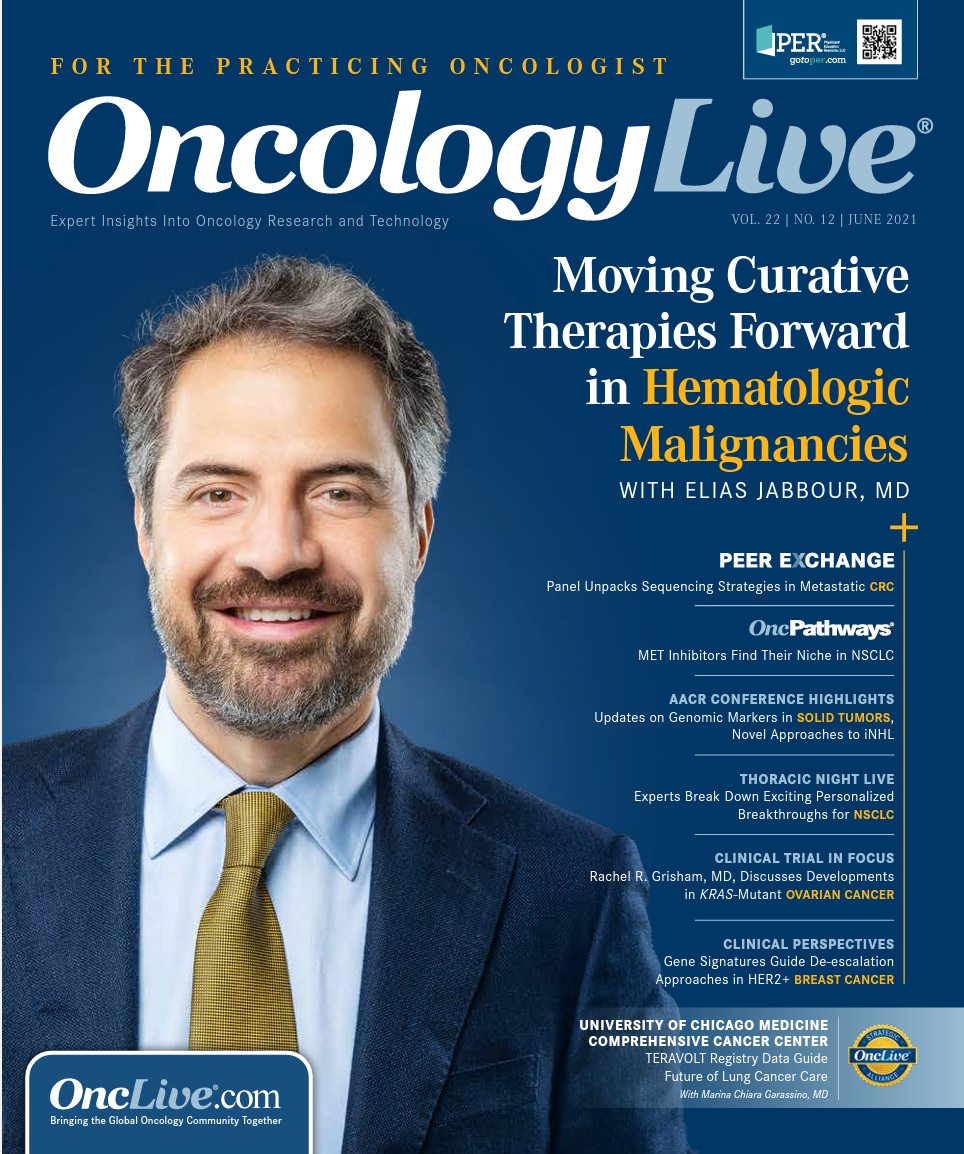Publication
Article
Sequencing Therapy in Metastatic CRC Is a Marathon, Not a Sprint
Author(s):
Actionable mutations identified in colorectal cancer have contributed significantly to the expansion of the therapeutic options available for patients with metastatic disease.
Joleen M. Hubbard, MD

Actionable mutations identified in colorectal cancer (CRC) have contributed significantly to the expansion of the therapeutic options available for patients with metastatic disease. For patients with unresectable, metastatic CRC (mCRC), palliative chemotherapy regimens remain the cornerstone of care. An increased focus on molecular profiling, such as the identification of BRAF or RAS mutations, microsatellite instability and DNA mismatch repair status, has increased the number of options available for patients in the first-line setting.1
Despite these advances, which includes marked improvements in overall survival (OS), treatment goals for patients who experience progression following frontline therapy focus on preservation of quality of life (QOL) and delayed disease progression.2 “[When selecting second-line treatment,] it’s really weighing the risks and the benefits,” Joleen M. Hubbard, MD, said during a recent OncLive Peer Exchange®. “We’re just trying to balance that quality and that quantity as long as we can.”
Hubbarb and other members of a panel of gastrointestinal cancer experts unpacked the available options and strategic sequencing decisions for patients moving into the second-line setting and beyond. Although they made clear that considerable work still needs to be done in treat-ing mCRC, they shared their insights on the growing number of clinically relevant treatment options and how they these use these agents in their own practices. “Treatment of metastatic colorectal cancer is like a marathon, rather than a sprint. We’re thinking [approximately] 2, 3, 4+ lines of therapy,” moderator Tanios S. Bekaii-Saab, MD, said.
Tanios S. Bekaii-Saab, MD

SECOND-LINE TREATMENT
In the second-line setting, the panelists said response to treatment is low. “From the various second-line trials that we have, it ranges anywhere from 5% to 15%. Sometimes it’s upward of 20%, but that’s really optimistic. Usually, we’re seeing a very minimal response,” Hubbard said.
She explained that in this setting, treatment response usually isn’t the goal given currently available treatment options. Instead, the goal is to enhance progression-free survival (PFS) and to help patients maintain as much QOL as possible. The exception to this is a patient who is highly symptomatic. “If they’re RAS/BRAF wild type and they haven’t used an EGFR inhibitor before, that might be a situation where I’d use an EGFR inhibitor to try to augment the response,” Hubbard said. Otherwise, she said she usually continues treatment with a VEGF inhibitor.
Although Hubbard said she usually uses FOLFOX (folinic acid, 5-fluorouracil, oxaliplatin) or FOLFOXIRI (folinic acid, 5-fluorouracil, oxaliplatin, irinotecan) in the first-line setting, in the second-line setting she is mostly using an irinotecan-based regimen, usually FOLFIRI (folinic acid, 5-fluorouracil, irinotecan), rather than reintroducing oxaliplatin, because many patients have some residual peripheral neuropathy. She explained that this is a setting where treatment can be adjusted to help improve a patient’s QOL. “If patients have a nice response but are getting fatigued from chemotherapy, you can go back to maintenance fluoropyrimidine, bevacizumab. You can go to a single agent, to irinotecan. There are a lot of things you can do to help ensure the quality of treatment because it’s a marathon,” she said.
The panelists proceeded to discuss rechallenging patients with oxaliplatin versus changing their treatment but noted that is only an option for select patients who do not have problematic neuropathy (grade ≥ 2). “There’s always the [risk of] oxaliplatin hypersensitivity that you may see on some records. You must discuss it with the patient. Some of it’s very serious, and I would never rechallenge such patients,” Cathy Eng, MD, said.
Cathy Eng, MD

They also noted that there may be a role for rechallenging patients with an anti-EGFR therapy, which is an approach currently under investigation. “The schools of thought are if you have a sufficient amount of time that has passed between your last EGFR, and you did have a good response to it and then acquired resistance to it, [you’re a likely candidate because you developed] that resistance through the KRAS clones, which tend to go away, usually at approximately 6 to 8 months, on average,” Kanwal P.S. Raghav, MD, MBBS, said.
The panelists explained that circulating tumor DNA, or liquid biopsy, is the most effective way to detect these clones. “The only way we are able to detect these alterations easily is through obtaining 1 to 2 tubes of blood and sending that off for molecular testing. What we’ve found is that just rebiopsying a tumor lesion, maybe a liver lesion, you might miss some of those resistance alterations. It’s really where the liquid biopsy performs at its best, particularly in comparison with a more conventional tumor tissue biopsy,” John H. Strickler, MD, said.
Subsequently, before considering rechallenging patients with anti-EGFR therapy, the panelists encouraged health care providers to test patients for these clones via liquid biopsy. However, they said, if liquid biopsy poses a financial hardship to a patient, it could be reasonable to wait 6 to 8 months after the patient’s initial exposure and then reintroduce anti-EGFR therapy since this is the period during which the clones usually disappear. They also emphasized that anti-EGFR rechallenge is only appropriate for patients who previously had a good response to this treatment but then progressed, and it is not for patients who had primary resistance to an anti-EGFR therapy.
Kanwal P.S. Raghav, MD, MBBS

BRAF-MUTATED mCRC
Patients with BRAF V600E-mutated mCRC have aggressive tumors that are often resistant to chemotherapy. Before some of the newer agents were approved, life expectancy was typically up to 1 year, with many patients unable to reach second-line therapy, Strickler explained. In these patients, the BRAF inhibitor encorafenib (Braftovi) in combination with the anti-EGFR antibody cetuximab (Erbitux) has been shown to be superior to traditional standards of care, and the combination was approved by the FDA on April 8, 2020, for previously treated adult patients with mCRC with a BRAF V600E mutation detected by an FDA-approved test.3 Approval was based on data from the randomized, active-controlled, open-label, multicenter BEACON CRC trial (NCT02928224), which showed a median OS of 8.4 months in the encorafenib plus cetuximab arm compared with 5.4 months in the control arm, in which patients received either irinotecan or FOLFIRI with cetuximab.
“It’s intriguing to me that here we’re adding an EGFR inhibitor, the RAF inhibitor, in patients who technically, because of the BRAF V600E mutations, would not respond to EGFR inhibitors,” Bekaii-Saab said. He explained that the BEACON CRC trial also included an arm that added a MEK inhibitor but that this agent did not add sufficient benefit to warrant FDA approval.
John H. Strickler, MD

Raghav shared his insights on why anti-EGFR does not work in patients with BRAF mutations. “It’s the EGFR, RAS, RAF, MEK pathway, and essentially with BRAF mutations, just like with KRAS mutations, the activation is downstream, so adding a single-agent anti-EGFR is probably not going to be effective,” he said. “[But if you use] a BRAF inhibitor, you block the originating signal, and then you add an anti-EGFR to block that upregulation that happens once you block the BRAF signal. The effect is still being brought about by BRAF, but the EGFR is preventing the escape mechanism from that BRAF.” He added that when you add a BRAF inhibitor in mCRC, it results in upregulation of EGFR, which is different from what has been observed with melanoma.
“Adding the MEK was just another layer that we thought would add a significant benefit because now you’re blocking all 3 players in that pathway,” Raghav said. He explained although there was some benef it to adding the MEK inhibitor, it was not significantly better than the doublet and it added toxicity.
When examining the updated results of the BEACON CRC trial, the median OS for both the doublet arm with encorafenib plus cetuximab and the triplet arm that added the MEK inhibitor binimetinib (Mektovi) was 9.3 months vs 5.9 months in the control arm.4 The confirmed overall response rate (ORR) was 26.8% for the triplet, 19.5% for the doublet, and 1.8% for controls. The rate of adverse events grade 3 or higher was similar between the triplet and control arms, occurring in 65.8% and 64.2% of patients, respectively, and lower in the doublet arm, occurring in 57.4%.
“The other intriguing aspect of [BEACON CRC] is when you add the EGFR inhibitor to the RAF inhibitor, you end up with fewer toxicities than with either alone. When you add the MEK inhibitor you end up with a nuclear explosion. But those 2, the cetuximab and encorafenib, seem to abrogate each other’s toxicity,” Bekaii-Saab said. It is still unclear why that is; Hubbard noted that similar results have been observed in melanoma research.
Based on the BEACON CRC findings, Stickler said the encorafenib plus cetuximab combination has become his preferred regi-men in the second-line setting and beyond for patients with BRAF V600E-mutated mCRC. Bekaii-Saab pointed out that when comparing patients receiving the regimen in the second line versus third line, those who received it in the second line fared better.
DATA SNAPSHOT. Real-World Results of the PRECONNECT study (NCT03306394)

THIRD-LINE TREATMENT AND BEYOND
Although the panelists felt clinical trial should be the first choice for patients in the salvage-line setting, they discussed 2 FDA-approved treatments that can be consid-ered for such patients: regorafenib (Stivarga) and TAS-102 (trifluridine/tipiracil; Lonsurf). They reiterated that in later lines, as in the second line, achieving response is not neces-sarily the goal. “Even if you’re able to control the disease at this stage, you will get some mileage in OS over time,” Raghav said.
In clinical trials of regorafenib, Raghav said OS ranged from 6 months to almost 9 months, with some real-world data also showing a survival of approximately 9 months. “Clearly, these agents do benefit a small subset of patients in whom they can cause disease control,” he said. He explained that regorafenib could be used as a third-line option, but that better biomarkers are needed to identify which patients derive the most benefit from it.
A challenge with regorafenib has been its toxicity profile, but a study led by Bekaii-Saab showed a lower incidence of AEs when a dose escalation strategy was used.5 Instead of starting patients on the standard 160-mg dose, they were titrated from 80 mg to 120 mg to 160 mg on a weekly basis, depend-ing on tolerability. “[This dosing strategy] did meet its primary end point of superiority, a better quality of life, better toxicity profile, and even better survival,” Bekaii-Saab said, noting that patients in the dose-escalation cohort reached an OS of 10 months.
TAS-102 has shown a similar OS as regorafenib, with a median OS between 7 and 8 months, a 2-month bene-fit over placebo.6,7 Real-world use of TAS-102 was assessed in the PRECONNECT study (NCT03306394), which showed safety and efficacy comparable to that observed in clinical trials, with QOL maintained during treatment.8 The panelists noted that an interesting aspect of this study was that approximately 33% of patients had previously received regorafenib. “[The study] showed that you can use TAS-102 at any point in the patient’s disease. Before or after regorafenib, it still has the same degree of efficacy,” Hubbard said.
Raghav said he usually uses regorafenib before he uses TAS-102 because there are some data for TAS activity in patients previously treated with regorafenib but no data for the reverse. Additionally, because most of his patients have come off chemotherapy, such as FOLFOXIRI, TAS-102 can be particularly diffi-cult for them to tolerate. “I give them TAS-102 and then they require transfusions…bottom line is that I’m not really using it regularly for most patients,” he said.
The panelists proceeded to briefly discuss data from Japan that showed OS is more favor-able when using regorafenib before an EGFR inhibitor (ie, cetuximab) vs doing the reverse in patients who are KRAS wild type.9 “That study was cut short, and we think it does need some additional validation in the United States, so that led to the REVERCE II trial,” Strickler said. REVERCE II (NCT04117945) is an ongoing phase 2 trial that is estimated to enroll 124 patients with mCRC who will be treated with regorafenib followed by cetuximab or panitumumab or the reverse sequencing.10 “It could be very constructive if that’s positive here as well,” Strickler said.
The panelists concluded their discussion of second-line and subsequent treatments by examining the novel agent fruquintinib, a selective oral inhibitor of VEGF receptors 1, 2, and 3, which showed benefit in the phase 3 FRESCO trial (NCT02314819) in China and was subsequently approved there in 2018.11 The agent, which is now being studied in the United States and globally in the phase 3 FRESCO-2 trial (NCT04322539), includes patients with mCRC who have progressed on or were intolerant to chemotherapy, biologics, and TAS-102 or regorafenib.12
“[In China, fruquintinib was given to] patients who were failed by all starter lines of therapy. Although only 30% of patients had prior bevacizumab, they noticed an improve-ment of almost 3 months for OS. This was a similar study design with a 2:1 ratio versus placebo and improved progression-free survival almost double. That’s why it was approved in China,” Eng said. FRESCO-2 will also have a 2:1 randomization and will require prior treatment with TAS-102, regorafenib, or both.
References
- Aparicio J, Esposito F, Serrano S, et al. Metastatic colorectal cancer. First line therapy for unresectable disease. J Clin Med. 2020;9(12):3889. doi:10.3390/jcm9123889
- Vogel A, Hofheinz RD, Kubicka S, Arnold D. Treatment decisions in metastatic colorectal cancer - beyond first and second line combination therapies. Cancer Treat Rev. 2017;59:54-60. doi:10.1016/j.ctrv.2017.04.007
- FDA approves encorafenib in combination with cetuximab for metastatic colorectal cancer with a BRAF V600E mutation. FDA. Updated April 9, 2020. Accessed May 24, 2021. bit.ly/3yDu0r4
- Tabernero J, Grothey A, Van Cutsem E, et al. Encorafenib plus cetuximab as a new standard of care for previously treated BRAF V600E-mutant metastatic colorectal cancer: updated survival results and subgroup analyses from the BEACON Study. J Clin Oncol. 2021;39(4):273-284. doi:10.1200/JCO.20.02088
- Bekaii-Saab TS, Ou FS, Ahn DH, et al. Regorafenib dose-optimisation in patients with refractory metastatic colorectal cancer (ReDOS): a randomised, multicentre, open-label, phase 2 study. Lancet Oncol. 2019;20(8):1070-1082. doi:10.1016/S1470-2045(19)30272-4
- Mayer RJ, Van Cutsem E, Falcone A, et al; RECOURSE Study Group. Randomized trial of TAS-102 for refractory metastatic colorectal cancer. N Engl J Med. 2015;372(20):1909-1919. doi:10.1056/NEJMoa1414325
- Xu J, Kim TW, Shen L, et al. Results of a randomized, double-blind, placebo-controlled, phase III trial of trifluridine/tipiracil (TAS-102) monotherapy in Asian patients with previously treated metastatic colorectal cancer: the TERRA study. J Clin Oncol. 2018;36(4):350-358. doi:10.1200/JCO.2017.74.3245
- Bachet JB, Wyrwicz L, Price T, et al. Safety, efficacy and patient-reported outcomes with trifluridine/tipiracil in pretreated metastatic colorectal cancer: results of the PRECONNECT study. ESMO Open. 2020;5(3):e000698. doi:10.1136/esmoopen-2020-000698
- Shitara K, Yamanaka T, Denda T, et al. REVERCE: a randomized phase II study of regorafenib followed by cetuximab versus the reverse sequence for previously treated metastatic colorectal cancer patients. Ann Oncol. 2019;30(2):259-265. doi:10.1093/annonc/mdy526
- Regorafenib, with cetuximab or panitumumab, for the treatment of unresectable, locally advanced, or metastatic colorectal cancer. ClinicalTrials.gov. Updated May 28, 2021. Accessed June 2, 2021. https://clinicaltrials.gov/ct2/show/NCT04117945
- Moehler MH, Stein A, Trojan J, et al. Regorafenib with TAS-102 (REGOTAS) in metastatic colorectal cancer patients who progressed after at least two standard therapies: efficacy and safety results of a multicenter phase I study (REMETY). J Clin Oncol. 2020;38(suppl 4):158. doi:10.1200/JCO.2020.38.4_suppl.158
- Pfeiffer P, Yilmaz M, Möller S, et al. TAS-102 with or without bevacizumab in patients with chemorefractory metastatic colorectal cancer: an investigator-initiated, open-label, randomised, phase 2 trial. Lancet Oncol. 2020;21(3):412-420. doi:10.1016/S1470-2045(19)30827-7
- Li J, Qin S, Xu R-H, et al. Effect of fruquintinib vs placebo on overall survival in patients with previously treated metastatic colorectal cancer: the FRESCO randomized clinical trial. JAMA. 2018;319(24):2486-2496. doi:10.1001/jama.2018.7855
- A study of efficacy and safety of fruquintinib (HMPL-013) in patients with metastatic colorectal cancer (FRESCO-2). ClinicalTrials.gov. Updated April 21, 2021. Accessed May 25, 2021. https://clinicaltrials.gov/ct2/show/NCT04322539










